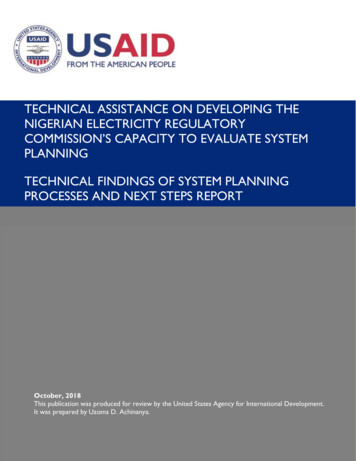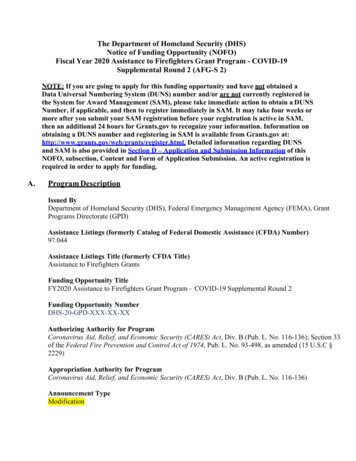
Transcription
TECHNICAL ASSISTANCE ON DEVELOPING THENIGERIAN ELECTRICITY REGULATORYCOMMISSION’S CAPACITY TO EVALUATE SYSTEMPLANNINGTECHNICAL FINDINGS OF SYSTEM PLANNINGPROCESSES AND NEXT STEPS REPORTOctober, 2018This publication was produced for review by the United States Agency for International Development.It was prepared by Uzoma D. Achinanya.
TECHNICAL ASSISTANCE ONDEVELOPING THE NIGERIANELECTRICITY REGULATORYCOMMISSION’S CAPACITY TO EVALUATESYSTEM PLANNINGTECHNICAL FINDINGS OF SYSTEM PLANNINGPROCESSES AND NEXT STEPS REPORTProject Title:Technical Assistance on Developing the Nigerian ElectricityRegulatory Commission’s Capacity to Evaluate System PlanningSponsoring USAID Office:AFR/SDCooperative Agreement:AID-OAA-A-16-00042Recipient:National Association of Regulatory Utility Commissioners(NARUC)Date of Publication:October, 2018Author:Uzoma AchinanyaThis publication is made possible by the generous support of the American people through the United StatesAgency for International Development (USAID). The contents are the responsibility of the NationalAssociation of Regulatory Utility Commissioners (NARUC) and do not necessarily reflect the views of USAIDor the United States Government.2 Page
Table of Contents1. Introduction . 82. Detailed Review of the Regulations and Requirements on System Participants. 92.1.Electric Power Sector Reform (EPSR) Act, 2005 . 92.2.The Grid Code . 92.3.The Market Rules . 102.4.The Distribution Code . 112.5.The Multi-Year Tariff Order (MYTO) . 113. Overview of System Planning Methodologies and Practice . 123.1.Overall Approach . 123.2.Load Demand Forecast . 123.3.System Representation in Modeling and Use of Software . 143.4.Key Analyses: Load Flow, Fault Levels and Stability Analyses . 153.4.1.Load Flow . 153.4.2.Fault Level . 163.4.3.Stability Analyses . 163.5.Investment Requirement and Least Cost/Best Fit Analysis; Optimal Power Flow . 173.6.Adequacy and Reliability Criteria . 183.7.Economic, Social, and Environmental Impact Analyses: Application of Cost-Benefit Methodologies194. Detailed Review of Current System Planning Objectives and Methodologies in Nigeria . 214.1.Load Forecast . 214.1.1.Abuja EDC . 224.2.Load Projection Report. 224.3.Generation Expansion Plan . 244.4.Generation Adequacy Report . 264.5.Transmission Expansion Plan . 274.6.Transmission Adequacy Report . 294.7.Distribution Expansion Plan . 304.8.System Adequacy Report . 375. Proposed changes to address deficiencies . 373 Page
5.1.Load Forecasting . 375.2.Generation Expansion Plan . 375.3.Generation Adequacy Report . 385.4.Transmission Expansion Plan . 385.5.Transmission Adequacy Report . 385.6. Distribution Expansion Plan . 395.6.1.Years of Projection . 395.6.2.Load Forecast . 395.6.3. Distribution Planning/System Studies & Analysis . 405.7.System Adequacy Report . 405.8.Software . 416. Overall Guide Structure and RAM Outline . 426.1.Overall Structure of the RAM Guide . 426.2.Review and Approval Procedures. 456.3.Implementation Monitoring Procedures . 49a.Generation Expansion Plan . 50b.Transmission Expansion Plan. 50c.Distribution Expansion Plan. 516.4. Outline of Review, Approval and Monitoring (RAM) Templates . 516.4.1.Review Templates . 516.4.2. Monitoring Templates . 787.Next Steps. 817.1.Load Demand Forecast . 817.2.Distribution Expansion Plan . 817.3.Credible Technical Assets Register. 827.4.Investment Procedure . 827.5.Generation and Transmission Expansion Plans (General) . 828.Conclusion. 839.Recommendations . 844 Page
Abbreviations and DefinitionsAEDCAbuja Electricity Distribution CompanyAGARApproved Generation Adequacy ReportAGPApproved Generation PlanAGPRApproved Generation Projection ReportALDFApproved Load Demand ForecastALPRApproved Load Projection ReportANEAvailable Net EnergyANGCAvailable Net Generation CapacityBEDCBenin Electricity Distribution CompanyCODCommercial Operation DateCYMDISTDistribution System AnalysisDEPDistribution Expansion PlanDEPSODiscrete Evolutionary Particle Swarm OptimizationDigSILENTDigital Simulation and Electrical Network calculationDiscoDistribution CompanyECEligible CustomerEEDCEnugu Electricity Distribution CompanyEIAEnvironmental Impact AssessmentEKEDCEko Electricity Distribution CompanyEPSRElectric Power Sector ReformESIAEnvironmental and Social Impact AnalysisEUEExpected Un-served EnergyFIRRFinancial Internal Rate of ReturnG&TGeneration and TransmissionGARGeneration Adequacy ReportGDPGross Domestic ProductGen. AdqcyGeneration AdequacyGencoGeneration CompanyGFGeneration ForecastGPGeneration PlanGPRGeneration Projection Report5 Page
GTmaxGeneration and Transmission OptimizationGWGiga WattIBEDCIbadan Electricity Distribution CompanyIKEDCIkeja Electricity Distribution CompanyIPPIndependent Power ProducerJEDCJos Electricity Distribution CompanyJICAJapan International Cooperation AgencyKAEDCKaduna Electricity Distribution CompanyKKEDCKano Electricity Distribution CompanykVkilo VoltkWkilo WattkWhkilo Watt hourLDFLoad Demand ForecastLECLevelized Electricity CostLOLELoss of Load ExpectationLOLFLoss of Load FrequencyLOLPLoss of Load ProbabilityLPRLoad Projection ReportMOMarket OperatorMWMega WattMWhMega Watt hourMYTOMulti-Year Tariff OrderNBETNigerian Bulk Electricity TraderNEPLANNetwork PlanningNERCNigerian Electricity Regulatory CommissionNESINigerian Electricity Supply IndustryOPFOptimal Power FlowPAPProject Affected PeoplePHEDCPort Harcourt Electricity Distribution CompanyPOFPlanned Outage FactorPowerGLFPower Geodatabase Load ForecastPPPPower Procurement Plan6 Page
PPAPower Purchase AgreementPSAFPower System Analysis FrameworkPSS/EPower System Simulator for EngineeringPVPhoto Voltaicp.u.per unitRAMReview, Approve and MonitorREMRemaining Energy MarginRESRenewable Energy ResourcesRGFRequest for Generation ForecastRGPRequest for Generation PlanRLDFRequest for Load Demand ForecastRMRemaining MarginSARSystem Adequacy ReportSCADASupervisory Control and Data AcquisitionSHShareholdersSINCALSiemens Network CalculatorSLDSingle Line Drawing/DiagramSLFStochastic Load FlowSOSystem OperatorSVCStatic Var CompensatorSYPCOAdvanced Power System Planning and Production CostingT&DTransmission and DistributionTCNTransmission Company of NigeriaTEPTransmission Expansion PlanTSPTransmission Service ProviderUOFUnplanned Outage FactorWBWorld BankYEDCYola Electricity Distribution Company7 Page
1.IntroductionPower system planning determines the future architecture of power generation, transmission anddistribution systems. Integrated approaches to system planning and grid expansion can facilitatebuilding an efficient power system, while maintaining affordability and reliability.Most power systems started as vertically integrated monopolies. System planning in these verticallyintegrated utilities was typically well-coordinated, with less chances of network congestion. It isobserved, however, that with restructured markets, it is difficult to have a properly coordinatedplanning. This is because the planning of the generation, transmission and distribution networkexpansion is conducted separately and independently, since they are managed by different entities.The effect of this situation is a disconnected system plan, resulting in system that is technically andeconomically inefficient.The Nigerian Power Sector commenced its sector reform program in the year 2004. By 2013, theprogram had progressed to the point where the generation and distribution assets were privatized.The transmission assets are still retained by the government, represented by the TransmissionCompany of Nigeria (TCN).Nigeria faced huge and persistent energy challenges over the past decades. The demand/supply gaphas continued to grow in spite of the power sector reform and privatization. The quality of powersupply is poor, not necessarily because of lack of investments in generation, transmission anddistribution infrastructure, but mainly due to inadequate management of resources and poor systemplanning. As a result of these problems, liquidity of the sector is adversely affected.In order to ensure a healthy sector profitability and sustainability, and support for the nation’s longterm economic goals, as well as ensuring a self-sustaining power sector, the Nigerian ElectricityRegulatory Commission (NERC) called for and received plans from the Transmission Company ofNigeria (TCN) and the eleven Distribution Companies (Discos), to guide the development of theNigerian power system for the next 20 years. In line with the requirements of the Electric PowerSector Reform Act in 2005, the Commission is reviewing these plans to ensure system integrationand reliability, as well as efficient impacts on the tariffs, among others.The fundamental objectives of this consultancy is for the consultant to provide the necessarytechnical support to enable the Commission review and approve the system plans submitted by theTransmission Company of Nigeria (TCN) and the Distribution Companies (Discos), and that thecapacity of the staff of NERC is enhanced, so that they are able to carry out future reviews andapprovals of system plans, without any external assistance or support. Apart from this, theconsultancy will assist in preparing the staff of the Commission for implementation and monitoringof the system plans. Consequently, this project has been designed in such a way that the NERCworking group members have a thorough understanding of the overall project objectives, and anunderstanding of the systematic process to be followed to achieve an efficient power system, withdetailed guidance from the consultant.In reviewing the plans, the consultant focused on the requirements of the relevant regulations andbest practices, including International best practices. Some of these requirements include, the needfor integration in the planning of the generation, transmission and distribution systems, the need for8 Page
affordability of the services from the systems, as well as the need for reliability and security of theservices.Apart from the development of a robust plan for the Nigerian power system, one of the expectedoutcomes of this exercise is the establishment of a process for determining the investmentsrequirements of the next 5 years for the distribution network, 10 years for the generation systemand 20 years for the transmission network. Another benefit is determining a reliable asset base fortariff decisions. More importantly, with a good understanding of the objectives and processes ofsystem planning, NERC staff will be left in a better position to carry out future reviews of thesystem plans for approval and to monitor the implementation of approved plans.The consultant’s approach and methodology in this project are based on his understanding of therequirements of the Nigerian electricity industry, and his knowledge and experience of typicalelectricity utility system planning assignment.2.Detailed Review of the Regulations and Requirements on SystemParticipantsAn efficient system plan should be consistent with the requirements of the relevant Regulations andapplicable best practices. Some of the Regulations, which have made provisions for system planningin Nigeria are as follows:2.1.Electric Power Sector Reform (EPSR) Act, 2005The Electric Power Sector Reform (EPSR) Act, 2005 gave legal backing to the reform of theNigerian power sector, and the privatization of the generation and distribution assets. The reformprogram started with the unbundling of the formally vertically integrated Nigerian power sectorinto generation, transmission and distribution entities and the horizontal unbundling of thegeneration and distribution parts of the industry into 6 generation companies and 11 distributioncompanies. The Act also provides the legal framework for the licensing of more generators as IPPs,for on-going improvement in generation capacity.The EPSR Act, 2005, Part VI: Consumer Protection and Licensee Performance Standards,Paragraphs 80 and 81, vests the power to set and enforce standards in the Nigerian power sectoron the Regulator (NERC). Whereas it is the responsibility of the operators to develop plans forthe development of their systems, the Act gives NERC the responsibility of evaluating andreviewing these plans to ensure they meet the necessary technical, economic and environmentalcriteria, before they are approved for implementation. The Regulator is also mandated by the Actto ensure, through effective monitoring exercises, that investments and procurements for thepower system are in line with the approved plans.2.2.The Grid CodeThe Grid Code specifies the day-to-day operating procedures and principles governing thedevelopment, maintenance and operation of an effective, well-coordinated and economictransmission system for the Nigerian power sector. The Grid Code is made up of four sections:General Conditions, Planning Code, Connection Code, and Operation Code.9 Page
The Planning Code, which is the main part of the Grid Code for system planning, provides theguidelines and requirements for the Transmission Service Provider (TSP) to perform the Longterm Expansion Planning of the Nigerian transmission system, to cater for the connection of newload/generation to the transmission system. The transmission expansion plan ensures that theimpacts of these new connections can be handled by the existing system. If not, it will identify theneed for the required expansion.The Grid Code specifies the technical and design criteria, and procedures to be applied in theplanning and development of the transmission network. It also specifies the demand data to beused by the Discos and the Eligible Customers in the development of forecasts for the loads tobe connected to the transmission network. Similarly, the Code provides the guidelines to beemployed by the generators in the provision of data related to the current and forecastgeneration plants to be connected to the transmission network.One major issue that needs to be resolved in the Grid Code is the assignment of roles to theTransmission Service Provider (TSP) and the System Operator (SO), in system planning. Theresponsibility for the development of the transmission network is that of the TSP, and not theSO, as stated in many places in the Grid Code. However, the responsibility for Load/GenerationProjection Reports is that of the System Operator, while the Market Operator prepares theAdequacy Reports for generation, transmission and the overall system.2.3.The Market RulesThe first logical step in the development of a plan for any system is the Load Forecast by the LoadParticipants and Load Projection by the System Operator. Every subsequent step in systemplanning is to satisfy these loads. The second logical step in system planning is to determine thegeneration capacity that will supply these forecasted loads, with some reserves, for security ofsupply. The transmission and distribution networks are only required for the purpose oftransporting the power from the generators to the loads, since power transmission anddistribution cannot be wireless.The Market Rules specify the timing, guidelines, procedures and horizons for the production ofLoad Projection and Generation Adequacy Reports that are the keys in system planning. TheLoad Projection Report considers the demand forecasts for each load participant and the entiresystem for ten years, using available information to determine future load growth. Suchinformation includes: Data and hypothesis provided by the Load ParticipantsHistorical load data and trends with respect to load growthExpected new connectionsOther parameters such as, economic growth, weather forecast, special events, populationgrowth, etc.The Rules specify the structure of the Load Projection Report (LPR) and requires the LPR toprovide for ten years, on a monthly basis, the following:a. The forecast system peak load and energy consumption for each month of the year,10 P a g e
b. The system generation capacity requirements for the forecasted system peak load, includingreserves,c. Forecasted energy consumption of each load participant,d. Expected new connections,e. Need for generation capacity reserves in each Disco due to expected transmission constraints,f. Best locations for new generation capacity, andg. Available free capacity in international interconnections.The Rules also specify the structure of the Generation Adequacy Report (GAR) and requires theGAR to provide for ten years, on a monthly basis, the following:a. The forecasted generation capacity requirement for each load participant and total for thesystem,b. The generation capacity bought in contracts by each load participant, andc. The generation adequacy, reflecting any shortfall or available reserve (i.e. a-b).2.4.The Distribution CodeThe Distribution Code specifies the day-to-day operating procedures and principles governingthe development, maintenance and operation of an effective, well-coordinated and economicdistribution system for the Nigerian power sector. The Distribution Code is made up of fivesections: General Conditions, Planning and Connection Code, Operation Code, Constructionand Maintenance Code, and Data Registration Code.The Planning Code, which is the main part of the Distribution Code for distribution systemplanning, contains the technical and design criteria and procedures to be followed by the Discosin the planning and development of the distribution system, to cater for connection of newloads/generators (embedded) to the network. The distribution expansion plan ensures that theimpacts of these new connections can be handled by the existing system, or if not, it will identifythe need for any required relief or reinforcement.Apart from specifying the criteria and procedures for distribution planning, the Distribution Codealso specifies the demand data to be used by the Discos in the development of forecasts for theloads to be connected to the distribution network.2.5.The Multi-Year Tariff Order (MYTO)The MYTO sets the wholesale and retail tariffs for the Nigerian electricity market over a periodof 15 years with provisions for annual minor reviews and 5-yearly major reviews. The Tariff Orderis designed to ensure adequate recovery of efficient costs in the production and delivery ofelectric energy in Nigeria.The Act mandates NERC to review and approve the system plans, developed by the systemparticipants, not only to ensure consistency with national goals, but also to ensure adequaterecovery of costs through efficient and balanced tariff determination. That is, the tariffs developedby the Regulator should not only ensure recovery of efficient costs of the infrastructure in thesystem plans, but also adequate consumer protection.11 P a g e
3.Overview of System Planning Methodologies and Practice3.1.Overall ApproachSystem Planning refers to the planning done to integrate new elements into the power grid,comprising of new generators, circuits, or equipment, as a result of changes in load demand. Thepurpose of planning is to ensure that the system will continue to operate reliably given changesto the system. Planning is performed at both the distribution and transmission levels, and it alsoincorporates generation planning.One of the planner’s main goals is to verify that new system elements will not adversely affectstability of the power grid. Their other main goal is to assess the outcome of the proposed projecton the system and how the system handles the new project. At the network level, plannerstypically look at designing, modeling and redesigning existing circuits to be able to supply powerby creating backup power flow routes. Also, as equipment is upgraded or load shifts, studies areconducted to determine the effects of changes in the power system. Another common study isto examine the impacts of new generation capacities on the local systems (for embeddedgenerators). If such capacity additions cause issues such as voltage limit violations, or overloadingof transformers, then upgrades will be needed. It is noted that Improvement in supply canprovoke additional load on the infrastructure.Power system planning is a continuous process which requires a number of professionals,including engineers, economists, managerial specialists along with some statisticians and weatherforecasters who work together to expand the power systems and operate them.System planning can be divided into three: short term planning, medium term planning and longterm planning. Short term planning is used to deal with contingencies, medium term planning usedto plan the maintenance of the components of the network, while long term planning is usedbasically for expansion and upgrade of the network.3.2.Load Demand ForecastLoad demand forecasting is about estimating future consumptions based on available data andinformation, as well as current consumer behavior. Load forecasts are extremely important toenergy suppliers and planners of electric power generation, transmission and distributionexpansions.Load demand forecast is the starting point in assigning inputs for load flow studies. Internationalbest practice requires that licensees in the electricity industry submit to the Regulator theirforecast of future load demand for the respective areas of supply of each licensee, for a projectednumber of years. The licensee is also required to furnish the Regulator with details of the dataand assumptions on which the forecast is based, along with the justification for the choice offorecasting methodology. Distribution network expansion plan, Transmission network expansionplan and Generation expansion plan are all developed based on the same Load Demand Forecast.There is an array of methods that are currently available for forecasting demand. An appropriatemethod is chosen based on the nature of the data available and the desired nature and level ofdetails of the forecasts. An approach often used is to employ more than one method and thencompare the forecasts to arrive at most accurate forecast. The forecaster may use a combination12 P a g e
of techniques that give him aggregate annual forecasts and those that predict hour-by hourdemand for electricity in individual sectors. This helps greatly in tariff setting and designingdemand-side management programs.Some of the broad categories of model approach of demand forecasting include:a. Simple Approachesb. Sophisticated Approachesa. Simple ApproachesThis approach uses simple indicators for forecasting, which include growth rates, elasticities,specific or unit consumption and energy intensity. For example,i. Growth Rate Based Method - The model equation is :Dt D0(1 g)tDt – load demand in year t,D0 – demand in the year 0,g – growth rate in demand.ii. Specific Consumption Method – Is the product of economic activity and unit ofconsumption for the activity. The equation is E A x U where A is level of activity and Uis energy requirement per unit of activity.iii. Regression – This is a widely used statistical technique employed to model the relationshipof load consumption and other factors such as weather condition, day types and customerclasses. This model assumes that the load can be divided in a standard load trend and atrend linearly dependent on some factors influencing the lo
COMMISSION'S CAPACITY TO EVALUATE SYSTEM PLANNING TECHNICAL FINDINGS OF SYSTEM PLANNING PROCESSES AND NEXT STEPS REPORT October, 2018 This publication was produced for review by the United States Agency for International Development. It was prepared by Uzoma D. Achinanya. 2 P a g e TECHNICAL ASSISTANCE ON DEVELOPING THE NIGERIAN ELECTRICITY REGULATORY COMMISSION'S CAPACITY TO EVALUATE .










